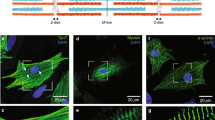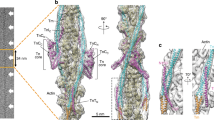Abstract
According to the cross-bridge model1–3 of muscle contraction, an interaction of myosin heads with interdigitating actin filaments produces tension. Although X-ray equatorial diffraction patterns of active (contracting) muscle show that the heads are in the vicinity of the actin filaments, structural proof of actual attachment of heads to actin during contraction has been elusive4. We show here that during contraction of frog skeletal muscle, the 5.9-nm layer line arising from the genetic helix of actin5 is intensified by as much as 56% of the change which occurs when muscle enters rigor, using a two-dimensional X-ray detector. This provides strong structural evidence that myosin heads do in fact attach during contraction6,7.
This is a preview of subscription content, access via your institution
Access options
Subscribe to this journal
Receive 51 print issues and online access
$199.00 per year
only $3.90 per issue
Buy this article
- Purchase on Springer Link
- Instant access to full article PDF
Prices may be subject to local taxes which are calculated during checkout
Similar content being viewed by others
References
Huxley, A. F. Prog. Biophys. biophys. Chem. 7, 255–318 (1957).
Huxley, H. E. Science 164, 1356–1366 (1969).
Huxley, A. F. & Simmons, R. M. Nature 233, 533–538 (1971).
Haselgrove, J. C. & Huxley, H. E. J. molec. Biol. 77, 549–568 (1973).
Selby, C. C. & Bear, R. S. J. biophys. biochem. Cytol. 2, 71–85 (1956).
Parry, D. A. D. & Squire, J. M. J. molec. Biol. 75, 33–55 (1973).
Squire, J. M. The Structural Basis of Muscular Contraction (Plenum, New York, 1981).
Cork, C., Fehr, D., Hamlin, R., Vernon, W. & Xuong, Ng. H. J. appl. Cryst. 7, 319–323 (1973).
Charpak, G., Hajduk, Z., Jeavons, A., Stubbs, R. & Khan, R. Nucl. Instrum. Meth. 122, 307–312 (1974).
Charpak, G., Petersen, G., Policarpo, A. & Sauli, F. Nucl. Instrum. Meth. 148, 471–482 (1978).
Charpak, G., Demierre, C., Kahn, R., Santiard, J. C. & Sauli, F. IEEE Trans. nucl. Sci. (New Ser.) 23, 200–204 (1977).
Breskin, A. et al. Nucl. Instrum. Meth. 143, 29–39 (1977).
Hendricks, R. W. Trans. Am. Cryst. Ass. 12, 103–146 (1976).
Lacy, J. L. & Lindsey, R. S. Nucl. Instrum. Meth. 119, 483–498 (1974).
Huxley, H. E. & Brown, W. J. molec. Biol. 30, 383–434 (1967).
Huxley, H. E. Cold Spring Harb. Symp. quant. Biol. 37, 361–376 (1972).
Haselgrove, J. C. J. molec. Biol. 92, 113–143 (1975).
Faruqi, A. R. & Huxley, H. E. in Scattering Techniques Applied to Supramolecular and Nonequilibrium Systems (eds Chen, S. H., Chu, B. & Nossal, R.) 201–227 (Plenum, New York, 1981).
Author information
Authors and Affiliations
Rights and permissions
About this article
Cite this article
Matsubara, I., Yagi, N., Miura, H. et al. Intensification of the 5.9-nm actin layer line in contracting muscle. Nature 312, 471–473 (1984). https://doi.org/10.1038/312471a0
Received:
Accepted:
Issue Date:
DOI: https://doi.org/10.1038/312471a0
This article is cited by
-
X-ray diffraction studies on thermally induced tension generation in rigor muscle
Journal of Muscle Research and Cell Motility (1996)
-
X-ray diffraction study on mammalian visceral smooth muscles in resting and activated states
Journal of Muscle Research and Cell Motility (1993)
-
Muscle contraction: Quick-frozen crossbridges
Nature (1985)
Comments
By submitting a comment you agree to abide by our Terms and Community Guidelines. If you find something abusive or that does not comply with our terms or guidelines please flag it as inappropriate.



